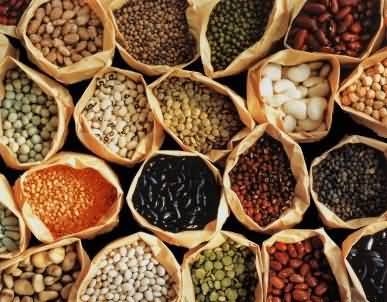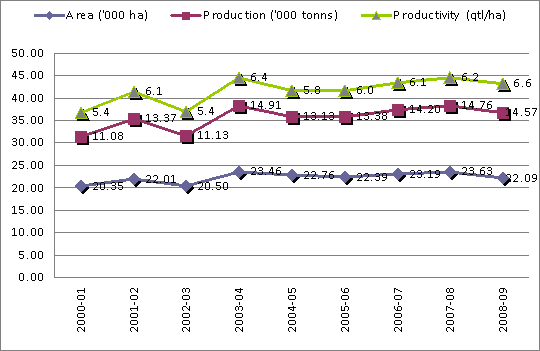स्थायी कृषि के लिए दानेदार फलीयॉं या दालें
 Grain legumes, also known as pulses, are plants belonging to the family Leguminasae, which are grown primarily for their edible grains or seeds. These seeds are harvested mature and marketed dry, to be used as food or feed. Traditionally the system of using legumes as the norm routine diet dates back to ancient times in India. India is largest producer of pulses in the world with 25 per cent share in global production. Chickpea, pigeonpea, mungnean, uradbean, lintil, and fieldpea are important pulses crop contributing 39 per cent, 21 per cent, 11 per cent, 10 per cent, 7 per cent and 5 per cent to the total production of pulses in the country. The total production was estimated 14.56 million tonnes and an area of 23.63 million hectares with average productivity 616 kg/ha (MOSPI, 2008-09) (Fig. 1). In recent years, price of legumes has been increasing drastically forcing small scale farmers to take up the crop at least for home consumption. These plants have the advantage of fixing atmospheric nitrogen for their own needs and for soil enrichment, thereby reducing the cost of fertilizer inputs in crop farming.
Grain legumes, also known as pulses, are plants belonging to the family Leguminasae, which are grown primarily for their edible grains or seeds. These seeds are harvested mature and marketed dry, to be used as food or feed. Traditionally the system of using legumes as the norm routine diet dates back to ancient times in India. India is largest producer of pulses in the world with 25 per cent share in global production. Chickpea, pigeonpea, mungnean, uradbean, lintil, and fieldpea are important pulses crop contributing 39 per cent, 21 per cent, 11 per cent, 10 per cent, 7 per cent and 5 per cent to the total production of pulses in the country. The total production was estimated 14.56 million tonnes and an area of 23.63 million hectares with average productivity 616 kg/ha (MOSPI, 2008-09) (Fig. 1). In recent years, price of legumes has been increasing drastically forcing small scale farmers to take up the crop at least for home consumption. These plants have the advantage of fixing atmospheric nitrogen for their own needs and for soil enrichment, thereby reducing the cost of fertilizer inputs in crop farming.

Figure 1. Area, Production and productivity of Pulses in India
Nitrogen Fixation:
Legumes form a symbiotic association with certain soil bacteria called rhizobia. These bacteria colonize in the root hairs of the legumes and multiply causing swellings, which become nodules. The bacteria benefit from the relationship by obtaining carbohydrates from the legume. The growing legume benefits from the nitrogen that is captured from the air by the bacteria and converted into ammonium within the nodules. The incorporated legume residues are a biological source of nitrogen that reduces the amount of fertilizer required for the following crop.
Legume: A good green manure
Legume crop is an integral part of the today’s farming. Adding crop residues or incorporating within 45 to 60 days of sowing to the soil helps maintain soil organic matter. This provides greater surface area for retaining all the nutrients and also increases the water holding capacity. The increase in soil organic matter increases nutrient availability and improves the physical properties of soil such as water infiltration, moisture storage capacity, aggregate stability, and resistance to erosion. Green manures function much like cover crops which help to protect the soil from wind or water erosion between normal cropping periods.
In Indo gangetic plains covering more than 1 million hectare, Rice-Wheat is the dominant rotation. Dhiancha is the best green manure which can be grown in between Wheat and Rice. After harvest of wheat, the field is given presowing irrigation and dhiancha seed @ 40-50kg/ha is broadcasted. After 50/60 days dhaincha crop is ploughed back in soil which can provide 50-60kg N/ha and 3-4 tonnes of dry mass.
Table 1: Addition of different grain legumes into the soil may provide the following amount of nitrogen.
|
Crop |
% Nitrogen |
|
Green gram |
30-40 |
|
Bean |
40-50 |
|
Horse Gram |
25-35 |
|
Garden pea |
50-60 |
Adaptability and Legume Cropping Systems:
In grain legumes, cultivars are given more importance for their ability to adapt to a given condition than their yielding ability. These do not grow better in wetland conditions. Compare to food crops, grain legumes have deeper root system. Hence many of them have drought resistant properties. Legumes are short duration crops and can be grown in variety of soils and atmosphere. Hence, they are suitable for mixed cropping, multiple cropping and crop rotation systems which are the ways to increase the diversity of the farming system. More diversity in the farming system generally means more stability and reduced pest and disease incidence.
When two or more crops with different rooting systems, a different pattern of water and nutrient demand, and a different above ground habit are planted together, nutrients and sunlight are used more efficiently. Therefore the combined yields of two crops grown as intercrops can be higher than the yield of the same crops grown as pure stand. Moreover, if there is crop loss due to diseases or insects or drought, it is possible to compensate from the second crop and maintain income stability. Early maturing green gram, beans and garden peas can be adopted in any cropping systems.
Cattle Feed:
Few pulse crops can also be grown as fodder crops and used to feed cattle. Usually kernels are mixed in cattle feed. The system of growing cowpea with maize (Fodder maize) is common in most parts of India. In western and central India Stylosanthes hamata, Stylosanthes scabra and Desmanthus virgatus are mixed with grasses like Sehima nervosum and Dichanthium annulatum for improving the fodder quality.
Nutritional Value of pulses:
India is more vegetarian than any other society in the world. Consequently, our dietary dependence on pulses as the main source of protein is enormous. Pulses are the most economic source of protein. The World Health Organization recommends 80 grams of pulses per person per day. Cereal grains are deficient in the essential amino acid, lysine. That is why a multitude of vegetarian cultures, in order to get a balanced diet, combine their diet of grains with legumes. Many legumes, on the other hand, are deficient in the essential amino acid methionine, which cereal grains contain. Thus a combination of legumes with grains can provide all necessary amino acids for vegetarians.
Table 2: Percent protein present in different pulses
|
Crop |
% Protein |
|
Pigeonpea |
20-26 |
|
Green gram |
23-32 |
|
Black gram |
23-26 |
|
Cowpea beans |
25-30 |
|
Horse gram |
23-32 |
|
Chickpea |
18-26 |
|
Garden pea |
21-32 |
|
Soya bean |
20-44 |
Pulses have considerably normal amounts of calcium, magnesium, phosphorous, zinc and iron elements. However, contain relatively higher quantities of vitamin ‘B’, whose deficiency causes many diseases including beriberi. Sprouted legumes are an excellent source of vitamin C and enzymes. The amount of fat varies from 1 to 6 % which is at the lowest level.
Hence, there is a high demand worldwide for legumes. The farmers who grow these crops can get sustainable income along with providing nutritional security for human health and sustainable soil health for increased productivity.
Authors:
H. Prashanth Banu, N.K. Chopra, S.S. Atwal, M. Athar
Indian Agricultural Research Institute
Regional Station, Karnal, Haryana
email:
